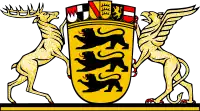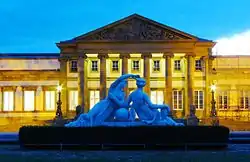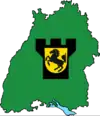Rosenstein Palace
Rosenstein Castle (German: Schloss Rosenstein) is a palace in Stuttgart, Germany. It was designed in the classical style by the architect and court builder Giovanni Salucci (1769–1845) as the summer palace for King Wilhelm I of Württemberg and was built between 1822 and 1830.
| Rosenstein Castle | |
|---|---|
Schloss Rosenstein | |
 Baden-Württemberg's Coat of Arms | |
 View at Night | |
 Schloss Rosenstein Location in Baden-Württemberg  Schloss Rosenstein Schloss Rosenstein (Germany) | |
| Former names | Die Kahlenstein (German: The Bald Rock) |
| Etymology | Die Rosenstein (German: The Rose Rock), for the rock it sits upon. |
| General information | |
| Status | Completed |
| Type | Palace |
| Architectural style | Classical |
| Location | Rosenstein Park |
| Town or city | Stuttgart |
| Country | Germany |
| Coordinates | 48°48′3.6″N 9°12′21.6″E |
| Elevation | 245 m (804 ft) |
| Named for | Rose garden on the palace grounds |
| Groundbreaking | 1824 |
| Construction started | 1824 |
| Completed | 1829 |
| Renovated | 1950–1960 1990–1992 |
| Demolished | 1944 |
| Client | State Museum of Natural History Stuttgart |
| Owner | State Museum of Natural History Stuttgart |
| Dimensions | |
| Diameter | 75 m × 47 m (246 ft × 154 ft) |
| Technical details | |
| Floor area | 3,235 m2 (34,820 sq ft) |
| Design and construction | |
| Architect(s) | Giovanni Salucci |
Today, the building houses that part of the State Museum of Natural History Stuttgart dealing with extant lifeforms.
Participating artists
Artists who participated in the construction and decoration of the palace were as listed below. Key to the abbreviations:
- NLE = No Longer Exists
- RE = Restored
- INT = Intact
Sculptors
| Status | Artist | Artworks |
|---|---|---|
| NLE | Albert Güldenstein | Two deer and two lions cast in bronzed zinc |
| INT | Albert Güldenstein | Two large candelabras |
| INT | Albert Güldenstein | Four small candelabra on the ramps |
| NLE | Albert Güldenstein | Small candelabra: eight in side porticos and eight in loggias |
| INT | Conrad Weitbrecht | The Four Seasons stucco frieze in the ballroom |
| INT | Friedrich Distelbarth | Artemis and Selene relief above the main entrance |
| INT | Johann Michael Knapp | Lions Gate Archway |
| INT | Johann Wilhelm Braun | Two muses |
| INT | Ludwig von Hofer | Venus of Phidias and Venus de Milo in the rose garden |
| INT | Ludwig Mack | Helios-relief on the rear façade |
| INT | Theodor Wagner | Six Muses, Small gable reliefs, four four garlands Friese, 16 medallions |
Painters
| Status | Artist | Artworks |
|---|---|---|
| NLE | Johann Friedrich Dieterich | Five ceiling frescoes in the dining room.[1] |
| NLE | Joseph Anton von Gegenbaur | Fresco in the dome and four frescoes in dome corners in the banquet hall; four frescoes in the Queen's library |
| NLE | Gottlob Johann Gutekunst | Frescoes of the barrel vault in the ballroom |
Trivia
- Before the construction of the palace, the hill Rosenstein Castle stands on was called Kahlenstein (German: Bald Rock) as it was bare of trees. Afterwards, it became known as Rosenstein (German: Rose Rock) because of the rose garden southeast of the palace.
- Directly under Rosenstein Castle is Württemberg's first railroad tunnel.[2] Constructed between July 1844 and July 1846, the tunnel is 326 metres (1,070 ft) long[2] and was used until a new tunnel, located further east and not passing under the castle, was completed in 1915.[3]
References
- Wenger, Michael (1995). "'Ein Meisterstück der Baukunst im ächt antiken Geschmack...'. Giovanni Salucci zum 150. Todestag. Ausstellung erinnert an den Baumeister". Schlösser Baden-Württemberg (in German). 2: 2–7.
- Mühl, Albert; Seidel, Kurt (1980). Die Württembergischen Staatseisenbahnen (in German) (2nd ed.). Stuttgart: Konrad Theiss Verlag. pp. 40–41, 264. ISBN 3-8062-0249-4.
- Dutt, Günter (1996). "Ein Streifzug durch 150 Jahre Tunnelbauwerke in Württemberg". Jahrbuch für Eisenbahngeschichte (in German). 28: 47–64. ISSN 0340-4250.
This article is issued from Wikipedia. The text is licensed under Creative Commons - Attribution - Sharealike. Additional terms may apply for the media files.
